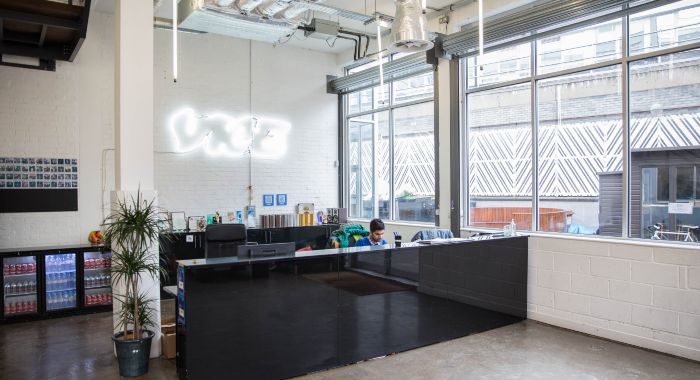Mexico City is Voguing
Sometimes finding the truest expression of yourself takes a community, a sense of belonging, and for members of the House of Apocalipstick—a vogue collective based in Mexico City—a family.
The sun is shining through a cloudless sky, it’s 31 degrees and on this particular Sunday afternoon it seems that everyone (and their dog) is meandering about Parque México, an art deco park in the centre of Mexico City’s effortlessly trendy and exceptionally green Condesa neighbourhood. Dotted with ponds, sculptures and wooden benches, there are food vendors selling aguas frescas (sugary fruit drinks) and couples taking salsa classes next to 20 dogs seated with military precision at obedience class. There are jugglers practicing, people dressed in white performing a moving meditation, and a soccer game being played in the same plaza. Surrounded by towering palm trees and flowering vines climbing the white pillars, beats are thumping at the centre of the Teatro al Aire Libre Lindbergh (Lindbergh Open Air Theatre). A small crowd gathers to watch an eclectic group of people standing in a circle, taking turns striking a pose to carefully curated techno-dance music.
“Dancing vogue feels like raw energy that moves your body in ways that you never expected—it makes you feel free,” says Omar Feliciano (aka Franka Polari), the ‘mother’ of the House of Apocalipstick, a collective of 40 vogue dancers who are members of the LGBTQ community. “You do it with a community every time so other people are also embracing what you’re becoming. It’s eye candy—people like to watch.”
The House of Apocalipstick—an interdisciplinary group of creatives—comprises men, women and trans people, including students, a poet, an architect, a mathematician, a photographer, a DJ, engineers, drag queen artists, and surprisingly, just two professional dancers. “The culture is spread by exposition,” says Feliciano. “We like to dance here because it’s a park full of life and expression. It’s the perfect place for us because it feels natural.”
Traditionally, vogue dancing occurs in three spaces: competitions; balls in different dance clubs; and parks and streets in public spaces during the day.
Vogue—a social, dance movement that originated from the ballroom culture of the African-American LGBTQ community in Harlem in the 70s and 80s—has made its way across the globe, landing in Mexico City (yes, it’s the same style of dance that gained mainstream exposure from Madonna’s 1990 music video for her song Vogue). Voguing creates the opportunity for dancers to become whatever version of themselves that they want, with no restrictions or hang-ups, as if money, race, and gender were of no concern. It’s about letting go of stereotypes and—even if just for a moment—being the fullest, truest expression of yourself.
"In the end, you find a community and people really embrace the sense of being sisters and brothers, so you don’t feel judged."
When it’s Feliciano’s turn, he does a few face frames, arm throws and hand gestures, then performs the death drop (aka the dramatic dip)—the ultimate expression of voguing—spinning in a circle, bending one knee and dramatically dropping his entire body to the ground in one fluid, jarring yet graceful movement.
“You just have to let go of everything and trust—it’s like jumping into the palm of God,” adds Feliciano, the only member of the house who can perform the death drop. “If you’re having fears, you can’t do the movement. It’s about feeling that I’m here, that I’m free and that I trust. You can tell when somebody is dancing from the heart because you can sense his or her power and spirit of freedom.”
So is it for other people or for self-liberation? “We dance for ourselves—to find ourselves,” he continues. “We dance because it's liberating. It's a way of breaking the chains that hold us back from finding our true self. We dance to tell our story to other people or the cameras. We dance to say, ‘We are here, we exist and our revenge is to be happy.’”
In 80s ballroom culture, a vogue house was an alternative family for marginalized people who had been rejected by their families and kicked out of their homes. Young people banded together to form vogue houses, who then competed against each other at various balls (friendly competition that is still a big part of the culture). Today, a vogue house is where you’ll find all traditional family roles and titles are replicated: mothers, fathers, sisters, brothers, and even grandmothers and grandfathers. “Fortunately, it’s not like voguing in the 80s when a ‘mother’ represented a [maternal figure] for people that didn’t have a family. We don’t have that extreme situation of marginalization,” says Miguel Fuentes Carreño, a House of Apocalipstick member who recently graduated with a degree in international relations and has a background in contemporary dance.
"It’s about feeling that I’m here, that I’m free and that I trust. You can tell when somebody is dancing from the heart because you can sense his or her power and spirit of freedom."
For Fuentes Carreño, joining the House of Apocalipstick created a place to explore his femininity and sexuality without being judged. “We experiment with what we consider gender, sexuality, sexual orientation and inclusion. Even though we’re still part of the marginalized LGBTQ community, for those who practice vogue it has expanded,” says Fuentes Carreño. “I’ve found it’s really opened my mind, not only the fact that I could just explore being feminine, which is usually very stigmatized and very stereotyped. Now, if I want to be feminine or masculine, I can be proud of it. In the end you find a community and people really embrace the sense of being sisters and brothers, so you don’t feel judged.”
He believes it’s a “fun” way to break down stereotypes. “The voguing community is inclusive, and because LGBTQ has been so invisible in recent years, voguing has helped to break those barriers,” says Fuentes Carreño.
Feliciano spent many years researching the movement before meeting Any “Funk” Alvarado, the pioneer of Mexican voguing, and mother of the House of Machos (the first vogue house in Mexico). Alvarado brought the culture back with him to Mexico after spending time in Los Angeles. “That’s when I decided I was not only trying to learn to dance, but also push the culture of the houses and the community, especially in violent times in a violent country,” says Feliciano, who has devoted the past three years of his life to promoting the culture, learning it to its core and building the House of Apocalipstick from scratch with the second mother of the house, Héctor Hugo Vargas Payán (aka Victoria Letal), a drag queen and contemporary performing artist.
“Any ‘Funk’ Alvarado started spreading the culture of voguing in Mexico, and when we met him we started talking about creating a ballroom scene here,” explains Payán. “There were already houses teaching the culture, steps, style and poses. Maybe we were voguing without even knowing it.”
“At the beginning, the first six months, it was like, ‘What are these people doing, why are they throwing themselves to the floor, what are they doing with their hands?’” says Feliciano. “Now people are starting to get interested and that’s what we want. It’s a way to get fit, and it’s a way to build a community in a healthy environment.”
Mexico City is socially progressive, but there are still many places where people can’t express being gay or trans, according to Feliciano, so the vogue community provides a safe space to explore, express, and let go. “We’re hated because we’re part of the LGBTQ community,” he adds. “But if you’re still clinging to your fears and apprehensions, instead of dancing and being free, you’re not able to perform [voguing] like it’s supposed to be performed. The way it’s supposed to be performed is whatever way makes you feel free.”
A power and spirit all wrapped up in pure emotion, he concludes. “Everything is about joy. We always say that we live in a world that hates us, but still we’re having a lot of joy and that’s our revenge.”
Originally published here: https://info.lululemon.com/features/up-close-and-personal/mexico-city-is-voguing


